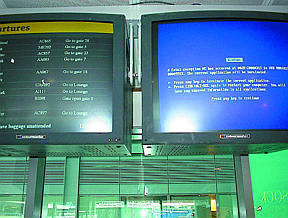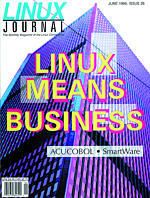

You arrive at the airport, in a hurry as usual. You look up at the flight departure screen and it says “A fatal exception OE has occurred at....The current application will be terminated...” You know the rest. This is the epitaph in blue that Windows issues for every application it terminates, also known as the Blue Screen of Death, or BSOD.
Lately Matt Michie, a writer and Linux hacker, has been keeping a growing gallery of public BSODs at his site (http://www.daimyo.org/bsod/), which ranks high among the many thousands of pages that show up in searches for “BSOD” or “Blue Screen of Death”. From what we can tell, these include a giant Las Vegas billboard, an airport flight schedule display, an ATM machine, a casino game, a building marquee and public signage of various unknown, but not unembarrassing, sorts.

LJ Index—May 2001

Number of e-mail packages other than Microsoft Outlook Express that could be infected by the Anna Kournikova virus: 0
Number of e-mails carrying the Anna Kournikova virus received by one Linux Journal editor on February 11, 2001: 15
Approximate number of people laid off by Eazel in March 2001: 40
Approximate number of SuSE employees at the time, worldwide: 600
Number of French schools now involved in the national Linux program: 350
Number of Linux distributions: 188
Number of embedded Linux OSes: 25
Total number of embedded Linux OSes as of last August: 17
Percentage increase in thin-client shipments during 1999: 90
Percentage of Fortune 100 companies that use thin clients: 80
Size of Amazon.com's announced layoffs in January 2001: 1,300
Size in millions of dollars of Amazon's stock trust fund for laid-off employees in Janurary 2001: 2.5
Percentage of internet usage within the US population in February 2001: 60
Millions of people logging on to the Internet in the US in February 2001: 169
Work access as a percentage of all net access in the US in February 2001: 14
Billions of wireless messages sent per month by the end of 2004: 244
Number of MP3s in the average peer-to-peer user's hard drive: 500
1: News.com
2: Doc Searls
3-4: Michael Hasenstein
5: LinuxWorld
6-8: TechWeb
9: International Data Corp.
10: Giga Information Group
11-12: Moneybox
13-15: News.com
16: News.com
17: Eric Garland of BigChampagne.com, from The Standard

LJ History
In the June 1996 issue of Linux Journal, we wrote that in addition to support for IA32, Amiga, and Atari, Linux is “being ported to several more platforms, including Alpha, ARM, MIPS and PowerPC.” Five years later, not only are these supported but also SuperH, SPARC and UltraSPARC, the S/390, VAX, PA-RISC, IA64, ColdFire, DragonBall, ETRAX, i960 and a host of others.
At this point it almost goes without saying that the predominant web server is Apache, which has had the top market share across all domains since early 1996, holding at better than 60% for the last year—according to Netcraft who has been studying the matter since September 1995. Back then the top server by a huge margin was NCSA's, which flatlined at approximately zero in 1999.
Apache is still doing fine, but it dropped by 1.29% in January of this year, Netcraft reports. Microsoft's IIS gained 1.82%, and Sun's iPlanet, the third-place server, dropped .29%. Both Apache, and Microsoft gained in absolute numbers. Netcraft found 16,207,982 domains served by Apache and 5,903,512 served by Microsoft. But there were other developments behind those details. Netcraft reports,
The relatively static market share for Microsoft on the Web as a whole contrasts sharply with its progress in our companion SSL Server survey where Microsoft makes consistent and relentless gains, month after month, and now accounts for 49% of the sites performing encrypted transactions on the Internet. Arguably, Microsoft's applications have made the difference, with there being no straightforward alternative to Microsoft's Commerce Server in the UNIX world.
Netcraft also reveals that PHP is being adopted at an extremely rapid pace:
The PHP module is compiled into the Apache server on over five million web sites, or approaching 40% of all Apache sites. Although PHP will only be in use on a fraction of these sites currently, it is regarded as easier to program than Perl or JSP and has created a broad developer community in a relatively short space of time. PHP, together with MySQL and Apache, has become the de facto way of developing web applications in the Linux environment, in a similar way to the IIS/ASP/SQL-server combination in the Microsoft world.
The Netcraft survey can be found at www.netcraft.com.
None of the Big Boys have gone as gaga over Big Tux as Big Blue. We all know about the billion IBM plans to spend. We've heard about the server division changes and the R&D commitments. We've seen the beanbag chairs rolled out for geeks at LinuxWorld Expo.
But, that's not enough. We're talking about a huge crush here: the kind that calls for big sloppy displays of unfettered affection. But since large corporations aren't able to actually hug and kiss (it would never get past Legal), IBM can't help doing what comes only naturally to big old companies—advertise.
“Peace, Love and Linux” is the new campaign. It launches with a love letter in the form of a Flash Q&A on the Web. Here's how it starts:
What is “Peace, Love and Linux?”
A rallying cry. A clear, enthusiastic synopsis of IBM's excitement about Linux and support for the Linux community.
Why is IBM supporting Linux?
Because we admire it, we believe in it, we need it and it's good for customers.
IBM's vision is to help build the business infrastructure of the future, drive towards dynamic e-business and integrated, intelligent infrastructure. The complexity and demands of this vision are staggering, mind-boggling. We've looked hard at what it will take to get there, and two facts have become clear.
First, we'll never get there without wide adoption of open standards like Linux.
Second, that the complexity of the task is so great that IBM simply can't do it alone. No company can do it alone (although some still suggest otherwise). Only the concerted effort of the larger technology community can make it happen. And only the Linux movement can marshal that effort.
Here's what IBM says to the natural skeptics that comprise, frankly, our readership:
Is this collaboration idea real or just feel-good stuff?
Real. Very real. If you think it's just fluff, you've missed the point.
IBM spends $5 billion a year on R&D. And we're putting a billion dollars behind Linux. But even all that is nothing compared to what the Linux community will generate spontaneously.
This is a new way of looking at the world: companies, alliances, partnerships and individuals working together, each contributing their particular expertise to create a “massively parallel thinking” force that is immeasurably more powerful than any single entity, including IBM.
As always with this kind of stuff, the lover holding out the flowers makes a few little mistakes. For example, IBM doesn't appear to know about the Linux community's allergy to GIFs. To arrive at the love letter (www-1.ibm.com/servers/eserver/linux/passport.swf), readers of IBM's Linux page have to click through a series of GIF links. And, lots of us will be disappointed when we get there because they don't run Flash, either.
So a little advice to the suitor here: maybe you could take some of the web marketing money that's burning a hole in your pocket and bang some of it on, say, the Open Source Initiative (http://www.opensource.org/). They need it, and it'll help them accomplish a bunch of the objectives you're bragging about.
—Doc Searls
We've just spent 14 hours trying to get standards-compliant code to work in standards-compliant browsers.
—Jeffrey Zeldman
The Linux issue is whether this is a fundamentally disruptive technology, like the microprocessor and the Internet. We're betting that it is.
—Irving Wladawsky-Berger of IBM
It's the business model around free software that concerns us, where people get sucked into not paying for software. This will be a disservice for them, as they need established, well-funded companies to offer innovation.
—Doug Miller, group product manager for Microsoft's Windows Server Group
The Linux community support model has resonated with people.
—Steve Ballmer, Microsoft CEO
In this business, the only real open-industry standard in the computer industry is Linux, which thankfully remains beyond the clutches of the moguls. Everything else is hokum designed to lock developers (and by extension, customers) into proprietary corners of the computing constellation.
—Charles Cooper, ZDNet News
Life ain't a rehearsal; stop acting and live.
—EliahuOne
Copyright today is a system inflicted on the public, not a system that benefits the public.
—Richard Stallman
